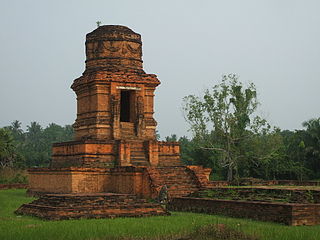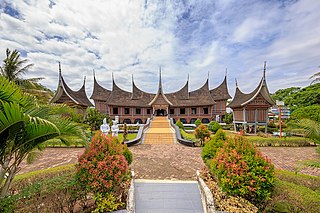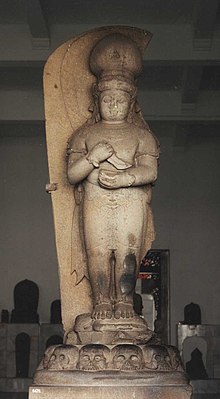
The 14th century lasted from 1 January 1301 to 31 December 1400 (MCD). It is estimated that the century witnessed the death of more than 45 million lives from political and natural disasters in both Europe and the Mongol Empire. West Africa experienced economic growth and prosperity.

West Sumatra is a province of Indonesia. It is on the west coast of the island of Sumatra and includes the Mentawai Islands off that coast. West Sumatra borders the Indian Ocean to the west, as well as the provinces of North Sumatra to the north, Riau to the northeast, Jambi to the southeast, and Bengkulu to the south. The province has an area of 42,119.54 km2 (16,262.45 sq mi),or about the same size as Switzerland,with a population of 5,534,472 at the 2020 census. The official estimate at mid 2022 was 5,640,629. The province is subdivided into twelve regencies and seven cities. It has relatively more cities than other provinces outside Java, although several of them are relatively low in population compared with cities elsewhere in Indonesia. Padang is the province's capital and largest city.

Nusantara is the Indonesian name of Maritime Southeast Asia. It is an Old Javanese term that literally means "outer islands". In Indonesia, it is generally taken to mean the Indonesian Archipelago. Outside of Indonesia, the term has been adopted to refer the Malay Archipelago.

Pagaruyung, also known as Pagarruyung, Pagar Ruyung and Malayapura or Malayupura, was a kingdom that once stood in the island of Sumatra and the seat of the Minangkabau kings of Western Sumatra. Modern Pagaruyung is a village in Tanjung Emas subdistrict, Tanah Datar regency, located near the town of Batusangkar, Indonesia.

The Melayu Kingdom was a classical Buddhist kingdom located in what is now the Indonesian province of Jambi in Sumatra.

The Pamalayu campaign was a diplomatic and military expeditionary force sent by the Javanese King Kertanegara of Singhasari to conquer the Sumatran Melayu Kingdom. It was decreed in 1275, though perhaps not undertaken until later.
Vikramavardhana (Indonesian : Wikramawardhana), regnal name Bhra Hyang Wisesa was a Javanese emperor and succeeded Rajasanagara Dyah Hayam Wuruk as the fifth monarch of the Majapahit empire, reigning from 1389 to 1429.
Ananggawarman was a crown prince (yuvaraja) of the Malayapura kingdom, which ruled at the end of the 14th century. The Malayapura kingdom was centered on the Minangkabau Highlands and its territory covers much of central Sumatra. The name Ananggawarman is inscribed on Saruaso II inscription as the son of King Adityawarman. It is not clear when Ananggawarman began to reign in place of his father, but it was written in the History of Ming that the kingdom sent a messenger again to China in 1376.

The Padang Roco Inscription, in Indonesian Prasasti Padang Roco, is an inscription dated 1286 CE, discovered near the source of Batanghari river, Padangroco temple complex, Nagari Siguntur, Sitiung, Dharmasraya Regency, West Sumatra, Indonesia.

Candi Bahal, also known as Biaro Bahal or Candi Portibi is Vajrayana Buddhist candi complex in Bahal village, Padang Bolak, Portibi, Padang Lawas Regency, North Sumatra, Indonesia. It is located about three hours journey with car from Padangsidempuan or 400 km from Medan. The complex includes three candis: Candi Bahal I, Candi Bahal II, and Candi Bahal III. The temple site is linked to Pannai Kingdom circa 11th to 13th century CE.
Dara Petak or Dara Pethak, also known in her formal name as Indreswari, was the consort of King Kertarajasa Jayawardhana, the founder of Majapahit kingdom. She was a Dharmasraya princess from Sumatra and the only non-Javanese wife of Kertarajasa, and also the mother of Jayanegara, the second monarch of Majapahit. Tradition mentioned her as a woman of exceptional beauty.
Dara Jingga, was one of the Malay Dharmasraya princess who was intended to be betrothed to Javanese King Kertanegara of Singasari after the Pamalayu expedition 1275–1293.

Adityawarman Museum is a State Museum located in Padang, Western Sumatra. As a State Museum, Adityawarman Museum is officially known as the State Museum of West Sumatra. The museum displays ethnographic collections of items related to the culture of the Province of West Sumatra, particularly the culture of Minangkabau and Mentawai.
Adwayawarman was the father of King Adityawarman of Malayapura kingdom as mentioned in the Kuburajo I Inscription. His alias name was Adwayadwaja, as he was called in the Bukit Gombak Inscription.
Bijayendrawarman was the name of one a yuwaraja of the Malayapura kingdom, who ruled in the 14th century in the Pasaman Regency, West Sumatra, Indonesia. Bijayendrawarman's name is written in Lubuk Layang inscription, found in Pancahan village, in Rao Selatan district of Pasaman. It was stated that he built a stupa, in a place called Parwatapuri.
Akarendrawarman was a ruler of Malayapura kingdom in the Minangkabau plateau. His name was found in the Pagaruyung VII inscription, which is written in Old Malay, his full title is Paduka Sri Maharajadhiraja Srimat Sri Akarendrawarman. In carrying out his administration, he was assisted by various other officials, among others was a minister called Tuhan (lord) Parpatih. The kingdom was mentioned to be located in Parhyangan on Mount Mahameru.
Lubuk Layang inscription, also known as Kubu Sutan inscription, is an inscription found in 1970 in Kubu Sutan, Lubuk Layang, Rao Selatan district, Pasaman Regency, of West Sumatra, Indonesia.

Saruaso II inscription, also previously known as Batusangkar inscription, is one of the inscriptions from the King Adityawarman era. It is currently located at the Fort van der Capellen area, in the courtyard of the old office of the Monuments Preservation Department, in Batusangkar city, West Sumatra, Indonesia. The inscription was previously displayed across in front of the Indo Jalito Building, which was the residence of the Regent of Tanah Datar during the Dutch colonial period. The inscription is written in Old Javanese script and Sanskrit language.

Kuburajo Inscription, also called Kuburajo I Inscription, is one of the many inscriptions left by King Adityawarman of central Sumatra. The inscription was found in Kuburajo village, Lima Kaum district, Tanah Datar Regency, West Sumatra, Indonesia in 1877 besides the main road from Batusangkar city to Padang city. The inscription was registered by N.J. Krom in Inventaris der Oudheden in de Padangsche Bovenlanden. The inscription is written in Sanskrit, and consists of 16 lines. This inscription was lost in 1987, but was rediscovered.

Inderapura, also known as Ujung Pagaruyung, was a kingdom located in the Pesisir Selatan Regency, present-day West Sumatra, bordering Bengkulu Province and Jambi. Officially, the kingdom was a vassal of the Pagaruyung Kingdom, although in practice it was independent and free to manage its internal and external affairs. The kingdom in its heyday covered the west coast of Sumatra from Padang in the north to Sungai Hurai in the south. Inderapura's most important products were pepper and gold.










